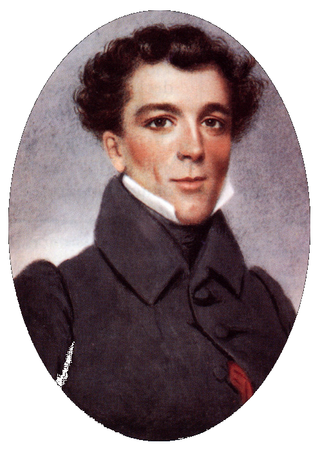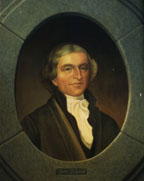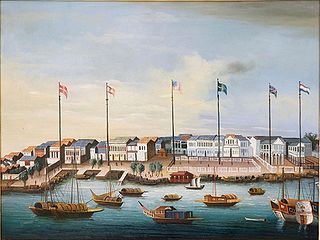
The Swedish East India Company was founded in Gothenburg, Sweden, in 1731 for the purpose of conducting trade with China and the Far East. The venture was inspired by the success of the Dutch East India Company and the British East India Company. This made Gothenburg a European centre of trade in eastern products. The main goods were silk, tea, furniture, porcelain, precious stones and other distinctive luxury items. Trade with China saw the arrival of some new customs in Sweden. The Chinese cultural influence increased, and tea, rice, arrack and new root vegetables started appearing in Swedish homes.

Captain Robert Bennet Forbes, was an American sea captain, China merchant and ship owner. He was active in ship construction, maritime safety, the opium trade, and charitable activities, including food aid to Ireland, which became known as America's first major disaster relief effort.

John Ledyard was an American explorer and adventurer.
Trade dollars are silver coins minted as trade coins by various countries to facilitate trade with China and the Orient. They all approximated in weight and fineness to the Spanish dollar, which had set the standard for a de facto common currency for trade in the Far East.

Canton or Cantonese porcelain is the characteristic style of ceramic ware decorated in Guangzhou, the capital of Guangdong and the sole legal port for export of Chinese goods to Europe. As such, it was one of the major forms of exportware produced in China in the 18th and 20th centuries.

The Canton System served as a means for Qing China to control trade with the West within its own country by focusing all trade on the southern port of Canton. The protectionist policy arose in 1757 as a response to a perceived political and commercial threat from abroad on the part of successive Chinese emperors.

Richard Chancellor was an English explorer and navigator; the first to penetrate to the White Sea and establish relations with the Tsardom of Russia.

The Old China Trade refers to the early commerce between the Qing Empire and the United States under the Canton System, spanning from shortly after the end of the American Revolutionary War in 1783 to the Treaty of Wanghia in 1844. The Old China Trade represented the beginning of relations between the United States and East Asia, including eventually U.S.–China relations. The maritime fur trade was a major aspect of the Old China Trade, as was illegal trafficking in opium. The trade era overlapped the First Opium War, which resulted from an attempt by China to enforce its prohibition on opium smuggling by Western traders and blockade-runners between 1839–1842.
John Henry Cox was an English explorer who charted Great Oyster Bay, Maria Island, and Marion Bay on the east coast of Tasmania in 1789, aboard his armed brig HMS Mercury.
William Bolts (1738–1808) was a Dutch-born British merchant active in India. He began his career as an employee of the East India Company, and subsequently became an independent merchant. He is best known today for his 1772 book, Considerations on India Affairs, which detailed the administration of the East India Company in Bengal which began shortly after their victory in the Battle of Plassey in 1757. The observations and experiences he recorded offer a unique resource for scholars inquiring into the nature of Company rule in Bengal. Throughout his life, Bolts continued to propose and execute various trading ventures on his own behalf and in conjunction with various commercial and governmental partners. The ventures of individual traders like Bolts did much to spur governments and large corporations into the expansion of their own interests.

Pazhou is a subdistrict of Haizhu in southeastern Guangzhou, Guangdong Province, in China.

The maritime fur trade was a ship-based fur trade system that focused on acquiring furs of sea otters and other animals from the indigenous peoples of the Pacific Northwest Coast and natives of Alaska. The furs were mostly sold in China in exchange for tea, silks, porcelain, and other Chinese goods, which were then sold in Europe and the United States. The maritime fur trade was pioneered by Russians, working east from Kamchatka along the Aleutian Islands to the southern coast of Alaska. British and Americans entered during the 1780s, focusing on what is now the coast of British Columbia. The trade boomed around the beginning of the 19th century. A long period of decline began in the 1810s. As the sea otter population was depleted, the maritime fur trade diversified and transformed, tapping new markets and commodities, while continuing to focus on the Northwest Coast and China. It lasted until the middle to late 19th century.

China–Portugal relations, can be traced back all the way to 1514 during the Ming dynasty of China. Relations between the modern political entities of the People's Republic of China and the Portuguese Republic officially began on 2 February 1979. China and Portugal established the comprehensive strategic partnership in 2005.
James Hanna was the first European to sail to the Pacific northwest to trade in furs. This maritime fur trade was an important factor in the early history of the Pacific Northwest and the westward expansion of the United States and Canada.
Edmund Roberts was an American diplomat. Appointed by President Andrew Jackson, he served as the United States' first envoy to the Far East, and went on USS Peacock on non-resident diplomatic missions to the courts of Cochinchina, Thailand ("Siam") and Muscat and Oman during the years 1832–6.
Austrian East India Company is a catchall term referring to a series of Austrian trading companies based in Ostend and Trieste. The Imperial Asiatic Company of Trieste and Antwerp and Asiatic Company of Trieste or the Trieste Company were founded by William Bolts in 1775 and wound up in 1785.

The Sydney punchbowls, made in China during the Jiaqing Emperor's reign (1796–1820) over the mid-Qing dynasty, are the only two known examples of Chinese export porcelain hand painted with Sydney scenes and dating from the Macquarie era. The bowls were procured in Canton about three decades after the First Fleet's arrival at Port Jackson where the British settlement at Sydney Cove was established in 1788. They also represent the trading between Australia and China via India at the time. Even though decorated punchbowls were prestigious items used for drinking punch at social gatherings during the 18th and 19th centuries, it is not known who originally commissioned these bowls or what special occasion they were made for.

The Consulate General of United States, Guangzhou is one of seven American diplomatic and consular posts in China. It is one of America's earliest diplomatic posts in the Far East. The consulate serves the South China region, covering the provinces of Guangdong, Guangxi, Hainan and Fujian, an area which, according to the latest census in 2020, has a resident population of over 220 million. The consulate general is also the only U.S. mission in Mainland China to process American adoptions and immigrant visas, making it one of the U.S. Department of State’s busiest consular-related posts.
East Asia–United States relations covers American relations with the region as a whole, as well as summaries of relations with China, Japan, Korea, Taiwan and smaller places. It includes diplomatic, military, economic, social and cultural ties. The emphasis is on historical developments.
Atahualpa was a United States merchant ship that sailed on four maritime fur trading ventures in the early 1800s. In 1813, in the Hawaiian Islands, Atahualpa was sold to the Russian-American Company (RAC) and renamed Bering or Behring. In January 1815 Bering, under the command of the American James Bennett, returned to Hawaii where it wrecked at Waimea Bay, Kauai.











